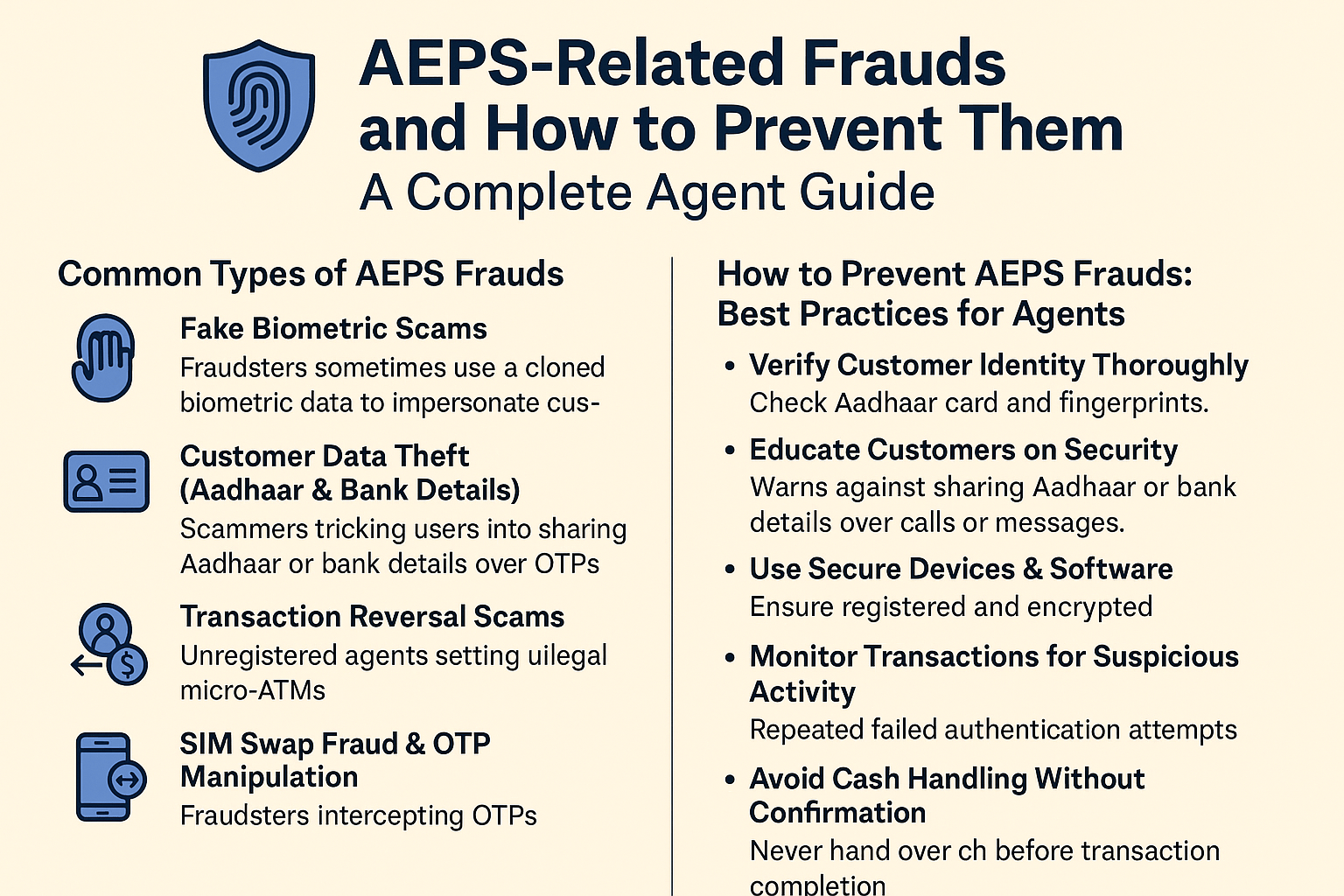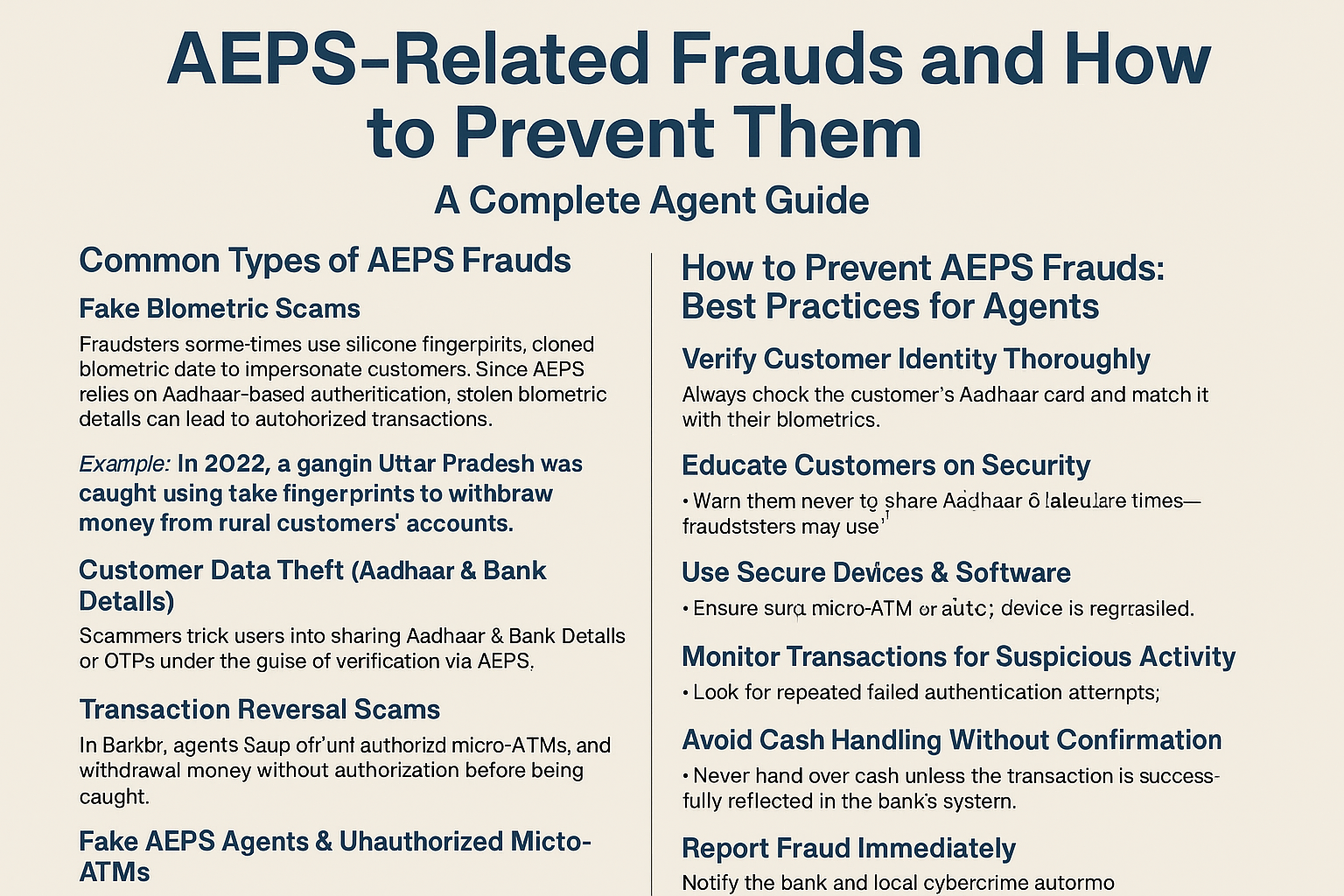Aadhaar Enabled Payment System (AEPS) has revolutionized banking in India, enabling millions to access financial services using just their Aadhaar number and biometrics. However, with its convenience comes the risk of AEPS-related frauds, where scammers exploit vulnerabilities to steal money from unsuspecting users. As an AEPS agent, it’s crucial to understand these frauds, recognize red flags, and implement preventive measures to protect your customers and your business.
In this guide, we’ll break down common AEPS frauds, real-life examples, and actionable steps to safeguard transactions.
Common Types of AEPS Frauds
1. Fake Biometric Scams
Fraudsters sometimes use silicone fingerprints or cloned biometric data to impersonate customers. Since AEPS relies on Aadhaar-based authentication, stolen biometric details can lead to unauthorized transactions.
Example: In 2022, a gang in Uttar Pradesh was caught using fake fingerprints to withdraw money from rural customers’ accounts.
2. Customer Data Theft (Aadhaar & Bank Details)
Scammers trick users into sharing their Aadhaar number, bank details, or OTPs under the guise of verification. Once obtained, they misuse this information for fraudulent transactions.
Example: A fraudster posing as a bank representative calls a customer, asks for their Aadhaar-linked bank details, and later siphons money via AEPS.
3. Transaction Reversal Scams
Some fraudsters initiate a transaction, take cash from the customer, and then reverse the transaction by exploiting system delays or glitches. The customer loses money, while the fraudster walks away.
4. Fake AEPS Agents & Unauthorized Micro-ATMs
Unregistered agents set up illegal micro-ATMs, collect customer data, and withdraw money without authorization.
Example: In Bihar, a fake agent operated for months, collecting Aadhaar details and draining accounts before being caught.
5. SIM Swap Fraud & OTP Manipulation
If a fraudster gains control of a victim’s mobile number via SIM swap, they can intercept OTPs and approve unauthorized AEPS transactions.

How to Prevent AEPS Frauds: Best Practices for Agents
1. Verify Customer Identity Thoroughly
-
Always check the customer’s Aadhaar card and match it with their biometrics.
-
Be cautious if the fingerprint scan fails multiple times—fraudsters may use fake fingerprints.
2. Educate Customers on Security
-
Warn them never to share Aadhaar or bank details over calls or messages.
-
Advise against using public Wi-Fi for banking transactions.
3. Use Secure Devices & Software
-
Ensure your micro-ATM or AEPS device is registered and encrypted.
-
Regularly update the software to patch security vulnerabilities.
4. Monitor Transactions for Suspicious Activity
-
Look for repeated failed authentication attempts.
-
If a customer reports an unauthorized transaction, alert the bank immediately.
5. Avoid Cash Handling Without Confirmation
-
Never hand over cash unless the transaction is successfully reflected in the bank’s system.
-
Be wary of customers insisting on instant cash before transaction completion.
6. Report Fraud Immediately
-
If you suspect fraud, notify the bank and local cybercrime authorities promptly.
-
Keep records of all transactions for dispute resolution.
Real-Life Case Study: How an AEPS Fraud Was Uncovered
In Rajasthan (2023), a group of fraudsters posed as banking correspondents, offering “instant loans” in exchange for Aadhaar details. They used these details to withdraw money via AEPS. The scam was uncovered when multiple victims reported unauthorized deductions.
Key Takeaway: Always verify credentials before sharing sensitive data.

Frequently Asked Questions (FAQs)
Q1. Can AEPS transactions happen without OTP?
Yes, AEPS primarily uses biometric authentication, so OTP is not always required. This makes securing biometric data crucial.
Q2. What should I do if a customer reports fraud?
-
Freeze further transactions.
-
Guide them to block their Aadhaar biometrics via the UIDAI website.
-
File a complaint with the bank and cybercrime cell.
Q3. How can I ensure my AEPS device is secure?
-
Purchase devices only from authorized vendors.
-
Enable two-factor authentication (2FA) where possible.
Conclusion
AEPS-related frauds are a growing threat, but with vigilance and proper precautions, agents can minimize risks. By verifying identities, educating customers, and using secure devices, you can protect both your business and your customers from financial losses.
Stay alert, follow best practices, and always report suspicious activity to authorities.
Disclaimer
This article is for educational purposes only. If you have any concerns regarding this content, please visit our DMCA page for removal requests. Always verify ownership or legal issues related to the information provided.
